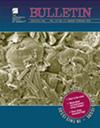Depositional processes of Marinoan-age diamictites and cap carbonates in northwestern Tarim, China: Implications for chemical weathering following the Marinoan deglaciation
IF 3.9
1区 地球科学
Q1 GEOSCIENCES, MULTIDISCIPLINARY
引用次数: 0
Abstract
The Marinoan diamictites and the overlying cap carbonates at continental margins bear key information on the paleo-environment evolution during the collapse of Snowball Earth, such as the timespan of intense chemical weathering. Such a sedimentary suite has been recently discovered in the northwestern Tarim Craton of China, but its depositional processes remain controversial. Here, we present stratigraphic and isotope geochemical studies on the diamictites of the Yuermeinak Formation and the overlying cap carbonates of the Sugetbrak Formation in the Aksu region of the northwestern Tarim Craton. Multiple unconformities in the region suggest major tectonic uplifting during the Cryogenian, probably resulting in a mountainous topography and varying dip directions of the overlying cap carbonates. The paleo-elevation of these mountains might have been higher and above sea level. We propose new depositional processes that involved four stages from glacial continental facies to neritic facies and/or alluvial fan systems. The first stage formed the massive diamictites and stratified siltstones with dropstones, recording cycles between glacier retreat and advance. The second stage involved the late transgression at the end of the deglaciation and the formation of calcareous massive diamictites with negative δ13C. The third stage included the onset of cap carbonate deposition and the alternating precipitation of calcareous mudstones and carbonates, reflecting frequent sea-level changes. The fourth stage was related to a widespread marine regression that developed a terrestrial environment and the sedimentation of the sandstones of the Sugetbrak Formation. Furthermore, we suggest that intense chemical weathering on exposed continents after the Marinoan deglaciation likely lasted for only hundreds of thousands of years, releasing ample alkalis into the ocean and facilitating the precipitation of the cap carbonates.塔里木西北部马里诺世二晶岩和盖层碳酸盐岩的沉积过程:马里诺世脱冰后化学风化的意义
马里诺二晶岩及其上覆的大陆边缘盖层碳酸盐岩提供了雪球地球崩塌时期古环境演化的关键信息,如剧烈化学风化作用的时间跨度。中国塔里木克拉通西北部新近发现了这样的沉积套,但其沉积过程仍有争议。本文对塔里木克拉通西北部阿克苏地区的尤尔美纳克组二晶岩和上覆苏格特布拉克组盖层碳酸盐岩进行了地层和同位素地球化学研究。该地区多处不整合面表明该地区在寒冰纪期间发生了大规模的构造隆升,可能造成了多山的地形和上覆盖碳酸盐岩倾角的变化。这些山脉的古海拔可能更高,高于海平面。我们提出了新的沉积过程,包括从冰川陆相到浅海相和/或冲积扇体系的四个阶段。第一阶段形成了大量的双晶岩和层状粉砂岩,记录了冰川后退和前进的循环。第二阶段为脱冰末期的晚期海侵,形成负δ13C的钙质块状二晶岩。第三阶段为盖层碳酸盐沉积开始,钙质泥岩与碳酸盐交替沉积,反映了频繁的海平面变化。第四阶段与广泛的海相退退形成陆相环境和苏格特布拉克组砂岩沉积有关。此外,我们认为马里诺冰川消退后暴露的大陆上强烈的化学风化作用可能只持续了数十万年,向海洋释放了大量的碱,促进了盖层碳酸盐的沉淀。
本文章由计算机程序翻译,如有差异,请以英文原文为准。
求助全文
约1分钟内获得全文
求助全文
来源期刊

Geological Society of America Bulletin
地学-地球科学综合
CiteScore
9.30
自引率
8.20%
发文量
159
审稿时长
4-8 weeks
期刊介绍:
The GSA Bulletin is the Society''s premier scholarly journal, published continuously since 1890. Its first editor was William John (WJ) McGee, who was responsible for establishing much of its original style and format. Fully refereed, each bimonthly issue includes 16-20 papers focusing on the most definitive, timely, and classic-style research in all earth-science disciplines. The Bulletin welcomes most contributions that are data-rich, mature studies of broad interest (i.e., of interest to more than one sub-discipline of earth science) and of lasting, archival quality. These include (but are not limited to) studies related to tectonics, structural geology, geochemistry, geophysics, hydrogeology, marine geology, paleoclimatology, planetary geology, quaternary geology/geomorphology, sedimentary geology, stratigraphy, and volcanology. The journal is committed to further developing both the scope of its content and its international profile so that it publishes the most current earth science research that will be of wide interest to geoscientists.
 求助内容:
求助内容: 应助结果提醒方式:
应助结果提醒方式:


